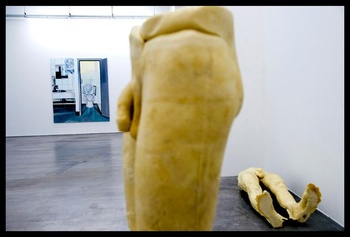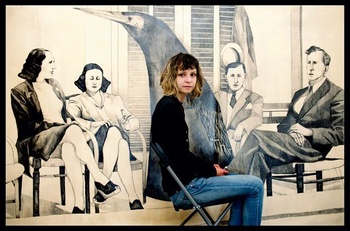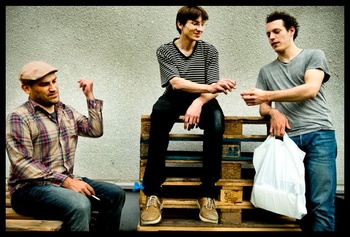(© Saskia Vanderstichele)
There is no denying that Wiels has established itself as an art centre that matters at the European level and even beyond. One aspect of the centre, which has continued to develop but is probably not so well known to the public, is its residency programme. Co-curated by Dirk Snauwaert, director of Wiels, and Agata Jastrzabek from Poland, ReSiDuE is the first exhibition, a posteriori and collective, to feature work by a selection of (nine) artists who have had residencies at Wiels. It is intended that there will be more in the future, on a regular basis. While the exhibition title also evokes the idea of residency, it first of all, humorously and ambiguously, refers to the idea of the residue left by a process, which may sometimes be just as important as the primary result actually aimed for. Which, in a way, at once underlines and counters the informal approach to residencies taken by Wiels.
ALEKSANDRA CHAUSHOVA
A BOOK ABOUT A BOOK
ReSiDuE: residents at the Wiels


Aleksandra Chaushova from Bulgaria was in residence at Wiels in 2008–2009, after studying graphic printing in Sofia. She has stayed put in Brussels since.
How did you fetch up in Brussels and at Wiels?
Aleksandra Chaushova: I didn’t know Brussels. It was my first residency abroad; I felt I needed to distance myself from my home context. That year at Wiels allowed me to see my past and the context I came from in perspective and to think about my work and reorient it. I learned a huge amount.
You are presenting a book.
Chaushova: A book, of which two copies have been printed so far [laughs], and framed drawings. It’s a book based on another book, Ardent Red, written by my mother, Ivaïla Alexandrova, which in turn focuses on a woman who was connected to the political and cultural elite of Bulgaria in the 1940s and 1950s. What interests me is the way fiction can never be dissociated from reality, memory, and seeing how history with a capital H is the sum, the convergence of many individual, subjective stories that have the potential to change its meaning.
Was that the reason why you made a book that is open to reappropriation?
Chaushova: Yes, I wanted my book to be an open book, with unbound leaves that can be manipulated. So the book potentially changes with each of its readers, who can radically change its order. And for the leaves, I have combined text extracts and photographs from the press or from contemporary archives with my own drawings, which themselves were based on photographs taken from the personal archives of the characters in the book, freely adapted or extended.
There is a sort of direct dream-like atmosphere about the drawings...
Chaushova: Yes, I deliberately introduced a dream-like, fantasy element into those compositions. I wanted to straight away sow doubt as to the work’s status, between fiction and reality. And I maintained that doubt in the choice of the framed drawings. Some of them are contained in the book; others are not – or could figure in it but have at times been slightly altered.
HOTEL CHARLEROI
LINKING THE BREWERIES
How did you fetch up in Brussels and at Wiels?
Aleksandra Chaushova: I didn’t know Brussels. It was my first residency abroad; I felt I needed to distance myself from my home context. That year at Wiels allowed me to see my past and the context I came from in perspective and to think about my work and reorient it. I learned a huge amount.
You are presenting a book.
Chaushova: A book, of which two copies have been printed so far [laughs], and framed drawings. It’s a book based on another book, Ardent Red, written by my mother, Ivaïla Alexandrova, which in turn focuses on a woman who was connected to the political and cultural elite of Bulgaria in the 1940s and 1950s. What interests me is the way fiction can never be dissociated from reality, memory, and seeing how history with a capital H is the sum, the convergence of many individual, subjective stories that have the potential to change its meaning.
Was that the reason why you made a book that is open to reappropriation?
Chaushova: Yes, I wanted my book to be an open book, with unbound leaves that can be manipulated. So the book potentially changes with each of its readers, who can radically change its order. And for the leaves, I have combined text extracts and photographs from the press or from contemporary archives with my own drawings, which themselves were based on photographs taken from the personal archives of the characters in the book, freely adapted or extended.
There is a sort of direct dream-like atmosphere about the drawings...
Chaushova: Yes, I deliberately introduced a dream-like, fantasy element into those compositions. I wanted to straight away sow doubt as to the work’s status, between fiction and reality. And I maintained that doubt in the choice of the framed drawings. Some of them are contained in the book; others are not – or could figure in it but have at times been slightly altered.
HOTEL CHARLEROI
LINKING THE BREWERIES

HOTEL CHARLEROI is a group of artists founded by Adrien Tirtiaux (Belgium), Antoine Turillon (France), and Hannes Zebedin (Austria), which emerged from a shared interest in the ruins of modernity and of industrial societies, crystallised by the context of Charleroi.
How did your group come into existence?
Adrien Tirtiaux: At first there was the desire to share a fascination with the Charleroi context, to try and live there for a while and do something there. And as there were no artists’ residencies, we decided to create our own flexible, mobile structure of residencies for exhibitions and interventions in the urban context. The formula changes every time. What we are interested in is putting our finger on things and thereby indirectly suggesting a reflection on the problems faced by the city and its inhabitants through artistic projects and interventions.
You seem to have operated in very different locations.
Tirtiaux: Yes, we started in 2010 in a house in Marcinelle. But the year after that, we were able to move into BPS22: fifteen of us artists set up our residential quarters with picture rails/walls we found down there, before intervening directly in the urban context. In 2012 we had the Palais des Expositions available to us [an abandoned Charleroi equivalent of the Heizel/Heysel - EL], which has 40,000 square metres, and this summer it will be the turn of a modernist brewery, the Brasserie des Alliés, which has been purchased by a private investor.
Which brings us to Wiels, another former brewery…
Tirtiaux: Yes, and we are going to create a link here with what will be going on in Charleroi via a webcam directly connected to the Brasserie des Alliés. At first, we even had ideas for crazy projects like developing a water shuttle between the two locations, via the Charleroi Canal. Concretely, we have decided to construct a platform in the Wiels entrance hall (using left-over panels from various exhibitions) where we will organise discussions and encounters throughout the exhibition. In addition, at the end of the exhibition, we will present a publication there that will round off these four years of HOTEL CHARLEROI’s activity.
Photos © Saskia Vanderstichele
RESIDUE • > 1/9, wo/me/We > zo/di/Su 11 > 18.00, €3/5/8, Wiels, avenue Van Volxemlaan 354, Vorst/Forest, 02-340.00.53, www.wiels.org
How did your group come into existence?
Adrien Tirtiaux: At first there was the desire to share a fascination with the Charleroi context, to try and live there for a while and do something there. And as there were no artists’ residencies, we decided to create our own flexible, mobile structure of residencies for exhibitions and interventions in the urban context. The formula changes every time. What we are interested in is putting our finger on things and thereby indirectly suggesting a reflection on the problems faced by the city and its inhabitants through artistic projects and interventions.
You seem to have operated in very different locations.
Tirtiaux: Yes, we started in 2010 in a house in Marcinelle. But the year after that, we were able to move into BPS22: fifteen of us artists set up our residential quarters with picture rails/walls we found down there, before intervening directly in the urban context. In 2012 we had the Palais des Expositions available to us [an abandoned Charleroi equivalent of the Heizel/Heysel - EL], which has 40,000 square metres, and this summer it will be the turn of a modernist brewery, the Brasserie des Alliés, which has been purchased by a private investor.
Which brings us to Wiels, another former brewery…
Tirtiaux: Yes, and we are going to create a link here with what will be going on in Charleroi via a webcam directly connected to the Brasserie des Alliés. At first, we even had ideas for crazy projects like developing a water shuttle between the two locations, via the Charleroi Canal. Concretely, we have decided to construct a platform in the Wiels entrance hall (using left-over panels from various exhibitions) where we will organise discussions and encounters throughout the exhibition. In addition, at the end of the exhibition, we will present a publication there that will round off these four years of HOTEL CHARLEROI’s activity.
Photos © Saskia Vanderstichele
RESIDUE • > 1/9, wo/me/We > zo/di/Su 11 > 18.00, €3/5/8, Wiels, avenue Van Volxemlaan 354, Vorst/Forest, 02-340.00.53, www.wiels.org
Read more about: Expo
Fijn dat je wil reageren. Wie reageert, gaat akkoord met onze huisregels. Hoe reageren via Disqus? Een woordje uitleg.